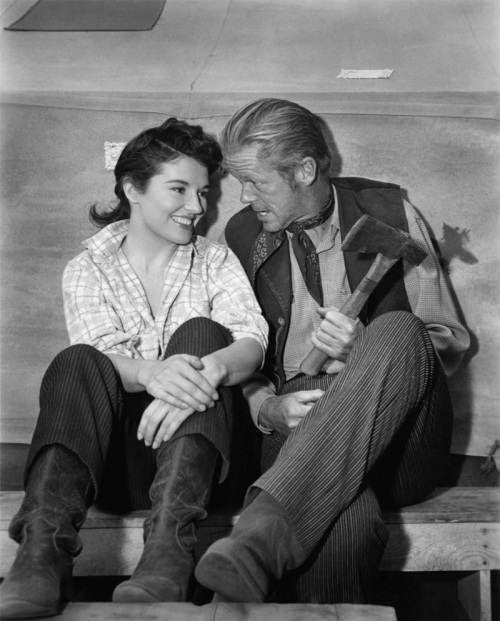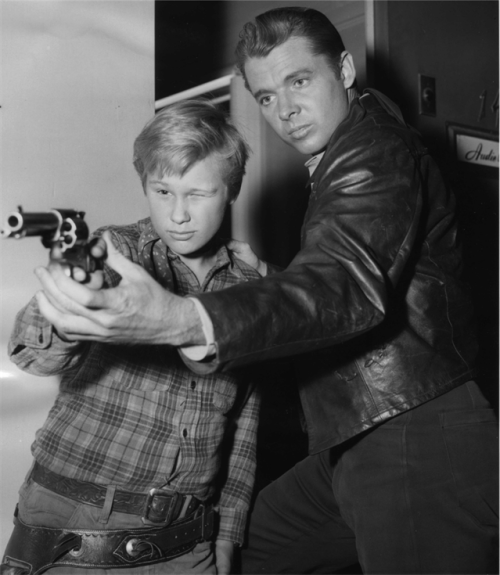
Directed by James Neilson
Produced by Aaron Rosenberg
Screenplay by Borden Chase
Based on a story by Norman A. Fox
Director Of Photography: William Daniels, ASC
Music composed and conducted by Dimitri Tiomkin
Film Editor: Sherman Todd, ACE
CAST: James Stewart (Grant McLaine), Audie Murphy (The Utica Kid), Dan Duryea (Whitey Harbin), Dianne Foster (Charlotte Drew), Elaine Stewart (Verna Kimball), Brandon de Wilde (Joey Adams), Jay C. Flippen (Ben Kimball), Herbert Anderson (Will Renner), Robert J. Wilke (Concho), Hugh Beaumont (Jeff Kurth), Jack Elam (Shotgun), Tommy Cook (Howdy Sladen), Paul Fix (Mr. Feeney), Olive Carey (Miss Vittles), James Flavin (Tim Riley), Donald Curtis (Jubilee), Ellen Corby (Mrs. Feeney), John Day (Latigo).
__________
Over the three-year life of this blog, few topics have generated the level of response as a recent post — nothing more than a few production photos, really — on Night Passage (1957). It’s a film with quite a history, and that history has affected its reputation to a large degree.
That history, in a nutshell. By the time Night Passage came around, James Stewart and Anthony Mann had collaborated on some of the greatest Westerns of all time (I’ll assume you know what those are). Stewart proposed Night Passage as their next film. And while there are numerous variations on how it came about (and which I will outline in my book if the film makes the cut), Mann did not end up directing the picture. That job went to James Neilson, a TV director and former still photographer making his feature debut on a very grand scale. (What a thankless task: there was no way this film wouldn’t be compared to the Mann-Stewart films.)

Producer Aaron Rosenberg: “I think Jim had grown tired of playing the anti-hero — the man with hate in his heart and a rage that leads him to violence.”**
Grant McLaine (Stewart) is a former railroad trouble shooter reduced to playing the accordion for tips. He’s re-hired to escort the payroll to the track’s end — the workers are plenty tired of having their pay stolen by Whitey Harbin (Dan Duryea) and The Utica Kid (Audie Murphy). Along the way, Stewart comes into contact with a number of people from his past — including his brother, The Uttica Kid. To go much further might spoil some of the fun.
The story is pretty simple, but Borden Chase’s script feels a bit over-plotted. Every character seems to have some kind of history with the others, bringing up relationships that don’t really impact the story. Of course, throughout the picture, we’re awaiting the meeting between Stewart and Murphy — the advertising was built around it — and our patience is certainly rewarded. Their scenes together are terrific, with Stewart trying to save his little brother’s soul and Murphy torn between the two sides of his personality. It all concludes with a well-staged shootout at a deserted mine.

The first film in Technirama — basically, VistaVision squeezed anamorphically to combine improved clarity and depth with the full Scope width — and shot around Durango, Colorado, Night Passage is a truly gorgeous thing to behold. William Daniels’ photography gives the picture a real epic feel, and avoids the tighter shots a TV director like Neilson tends to gravitate towards. It seems like the bulk of the film takes place outdoors, and the location work was grueling.
Dianne Foster: “That was a hard picture to do. We started in late autumn and were trying to get out by winter because snowfall would have changed the landscape, so we were on a tight schedule. We had trucks with oxygen masks and cots in them, set up like a mini-hospital… We would do a sequence and then get so winded and exhausted that we’d have to go lay down for a while, get some oxygen and then go back in and finish the scene… the schedule stretched from weeks into months, and in the end we still had to shoot some scenes with rear projection in the studio.”*

Along with its grand scale, action sequences and startling location work, the performances really stand out in Night Passage. Stewart is as good as ever, though his part isn’t as troubled, or flashy, as in the Mann films. He’s at his best in the touching, pivotal scene with Audie Murphy. This may be the best performance of Murphy’s career. From his enjoyment in taunting Duryea to his powerful scene with Stewart, everything he does rings true. It’s a complex part and he nails it.
The way Dan Duryea plays Whitey is rather odd. The character is a bit under-developed, which may have led Duryea to play it broadly, and loudly — he screams every line. But his scenes with Murphy, as the Utica Kid needles Whitey, are tense and funny. Elaine Stewart and Dianne Foster don’t have much to do, but do it well.

The supporting cast is terrific: Jay C. Flippen, Brandon de Wilde, Hugh Beaumont, Jack Elam, Robert J. Wilke, Paul Fix, Olive Carey and Ellen Corby. And Dimitri Tiomkin’s score is as excellent as you’d expect.
Night Passage delivers on everything it promises, and it’s time for it to come out from the sizable shadow created by its older brothers, the Mann-Stewart films. Kinda like the Utica Kid.
To promote Night Passage, Murphy made an appearance in Salt Lake City before its premiere on July 18, 1957, touching on his PTSD in a newspaper interview. Stewart hit the road for the picture as well, and he never worked with Anthony Mann again.
Suggested reading: the comments from my previous Night Passage post, along with the excellent write-ups on it at Laura’s Miscellaneous Musings and Riding The High Country.
SOURCES:
* Last Of The Cowboy Heroes by Robert Nott; ** Jimmy Stewart: The Truth Behind The Legend by Michael Munn.
Read Full Post »

























